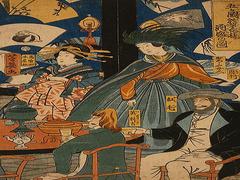Introduction
Japanese woodblock printing, known as ukiyo-e, has a rich history dating back centuries. Among the vast collection of ukiyo-e prints, there exists a print that holds the distinction of being the oldest surviving example of this remarkable art form. In this article, we delve into the origins and significance of the oldest Japanese woodblock print, providing insight into its historical and cultural importance.
The Hyakumantō Darani: A Glimpse into the Past
The oldest Japanese woodblock print is the Hyakumantō Darani, which translates to "One Million Pagodas and Darani." It is a Buddhist charm that dates back to the 8th century during the Nara period (710-794). The print features a repeating pattern of miniature pagodas accompanied by a sacred chant, or darani, printed in Chinese characters.
Origin and Purpose
The Hyakumantō Darani was created under the order of Empress Shōtoku, a devout Buddhist ruler. The purpose of these charms was to distribute them as religious offerings to temples throughout Japan. The printing of one million copies of the darani was believed to bring blessings, protect against evil, and promote spiritual well-being.
Printing Technique
The Hyakumantō Darani was produced using a woodblock printing technique known as mokkan. Mokkan refers to small, rectangular wooden tablets used for writing prayers or dedicatory inscriptions. The tablets were carved with the darani text and then inked and pressed onto paper to create the prints. This process predates the more intricate techniques associated with ukiyo-e prints that emerged later.
Discovery and Preservation
The survival of the Hyakumantō Darani is remarkable, considering its age and the fragility of the materials involved. The oldest known copy of this woodblock print was discovered in 1966 at the Hōryū-ji temple in Nara, Japan. It was found inside one of the temple's pagodas, where it had been carefully preserved for centuries. The print is currently held by the temple and is regarded as a significant cultural artifact.
Historical and Cultural Significance
The Hyakumantō Darani serves as a testament to the early adoption of woodblock printing techniques in Japan and the influence of Buddhism on the development of printing technology. It represents a critical intersection of art, religion, and technology during the Nara period.
Furthermore, the darani itself holds great cultural importance. In Buddhist practice, the darani is considered a powerful incantation that carries spiritual significance. The distribution of these charms played a role in the dissemination of Buddhism and its teachings throughout Japan.
Preservation and Legacy
The discovery and preservation of the Hyakumantō Darani have allowed researchers and historians to gain insights into the early history of woodblock printing in Japan. This rare artifact offers a glimpse into the origins of a printing tradition that would later evolve into the renowned ukiyo-e prints of the Edo period.
The Hyakumantō Darani stands as a testament to the enduring nature of woodblock printing as a medium of artistic expression and religious devotion. It serves as a reminder of the cultural and historical richness of Japan, preserving a vital piece of the nation's artistic and spiritual heritage.
Conclusion
The Hyakumantō Darani holds a special place as the oldest surviving Japanese woodblock print. This remarkable artifact not only showcases the early development of woodblock printing techniques in Japan but also sheds light on the role of Buddhism in the dissemination of print culture during the Nara period. Its discovery and preservation have allowed us to delve deeper into the origins of ukiyo-e and appreciate the historical and cultural significance of this ancient art form.
- Unveiling the Artistic Process: Steps of Woodblock Printing
- Japanese Woodblock History - Ukiyo-e: The Floating World Unveiled - A Journey into the Artistic Splendor of Japanese Woodblock Prints
- The History of Japanese Woodblock Printing
- The Artistic Journey: Exploring the Rich History of Japanese Woodblock Prints
- The Birth of a Revolutionary Technique: Woodblock Printing and the Tang Dynasty
- The Innovative Legacy: How Woodblock Printing Led to Remarkable Inventions
- The Significance of Japanese Woodblock Printing: A Timeless Artistic Legacy
- Unlocking the Beauty: How to Identify Japanese Woodblock Prints
- Unveiling the Ancient Art: Exploring the Oldest Japanese Woodblock Print




